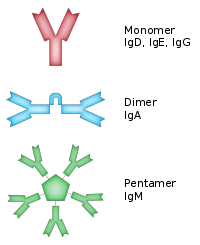Isotype (immunology)

In immunology, the "immunoglobulin (AKA antibody) isotype" refers to the slight phenotypic variations within the immunoglobulin gene family that encode for variant immunoglobulin heavy chains and immunoglobulin light chains. To be an isotype of a particular gene family means to belong to a set of genes that encode functionally similar proteins. Usually, isotypes that belong to a particular gene family are duplicate copies of the same gene that arose because of a mistake during DNA replication. As the species continues to evolve, those duplicated genes are passed on from generation to generation until every member of the species has a copy. Each of those genes have since undergone mutations of their own, such that they diverge slightly in structure and function, giving rise to the different isotypes known today.
In humans, there are five heavy chain isotypes and two light chain isotypes:
Cells that express immunoglobulin proteins are called B cells, and the isotype that they secrete changes depending on a few variables. Some variables include exposure to antigen, interaction with T helper cells, and the composition of cytokines surrounding them. These variables all add up to mount a defensive response called the adaptive immune response. One of the main physiological changes that occurs during an adaptive immune response is a process called immunoglobulin class switching. The function of the antibody and its sub-localization within the body changes depending on the isotype class that it switches to.[1]
Class Switching
Every single B cell only expresses one of the light-chain isotypes and sticks with that "choice" for its lifetime. This designation occurs prior to the B cell's full maturation. All daughter cells that may arise from this original B cell will also have this same light-chain.
On the other hand, immunoglobulin class switching causes heavy chain rearrangement of the mature B cell. .[2] A mature, naive B cell expresses both the IgM and IgD classes.[3] Class switching only occurs after the B cell binds an antigen through its B cell receptor, and is activated through interaction with a T helper cell.[4] This two-step check is necessary prior to the B cell's undergoing cell division, creating daughter cells. Through the use of several key enzymes, like AID (Activation-Induced Cytidine Deaminase), the daughter B cell performs DNA recombination and removes the genes for IgM and IgD, among others.[5] This assures that the B cell cannot express any more IgM-class or IgD-class antibodies and will begin to express one of the other classes. By undergoing DNA recombination, the daughter B cells can select for the heavy-chain class that localizes to the part of the body that may more effectively fight the foreign invader. The way the B cell "select" which isotype to express and which isotypes to excise during DNA recombination is dependent upon which cytokine signals are present near the B cell at the time of recombination.
See also
References
- ↑ Janeway, CA; Travers, P; Walport, M; et al. (2001). "Immunobiology: The Immune System in Health and Disease. 5th edition.". NCBI. NCBI. Retrieved 2016-01-19.
- ↑ Stavnezer, Janet (1996). "Immunoglobulin Class Switching". Current Opinion in Immunology. doi:10.1016/s0952-7915(96)80058-6. PMID 8725943. Retrieved February 17, 2016.
- ↑ Pei, Tong; Wesemann, Duane (2015). Molecular Mechanisms of IgE Class Switch Recombination. Cham: Springer International Publishing. p. 23. ISBN 978-3-319-13725-4.
- ↑ Alberts, Bruce; Johnson, Alexander; Lewis, Julian; Raff, Martin; Roberts, Keith; Walter, Peter (2002-01-01). "Helper T Cells and Lymphocyte Activation".
- ↑ Chandra, Vivek; Bortnick, Alexandra; Murre, Cornelis (2015-09-01). "AID targeting: old mysteries and new challenges". Trends in Immunology. 36 (9): 527–535. doi:10.1016/j.it.2015.07.003. PMC 4567449
 . PMID 26254147.
. PMID 26254147.
External links
- Immunoglobulin Isotypes at the US National Library of Medicine Medical Subject Headings (MeSH)
- Overview at University of South Carolina School of Medicine
- Overview at Southern Illinois University Carbondale